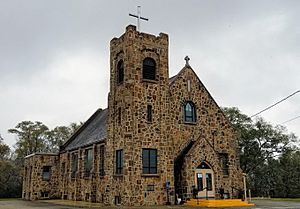Jacobs Prairie, Minnesota facts for kids
Quick facts for kids
Jacobs Prairie
|
|
|---|---|

St. James Catholic Church, 2020
|
|
| Country | United States |
| State | Minnesota |
| County | Stearns |
| Township | Wakefield Township |
| Elevation | 1,152 ft (351 m) |
| Time zone | UTC-6 (Central (CST)) |
| • Summer (DST) | UTC-5 (CDT) |
| ZIP code |
56320
|
| Area code(s) | 320 |
| GNIS feature ID | 645572 |
Jacobs Prairie is a small, quiet community in Minnesota, United States. It is an unincorporated community, which means it doesn't have its own local government like a city or town. Instead, it's part of Wakefield Township in Stearns County. You can find it along Stearns County Road 2, close to the towns of Cold Spring and Rockville.
Contents
History of Jacobs Prairie
Early Settlers and Community Life
Jacobs Prairie began in 1854 when families started to settle and build farms there. Many of these early settlers were Catholic people who spoke German or Luxembourgish. They came from places like Bavaria and the Eifel region.
A Roman Catholic priest named Fr. Francis Xavier Pierz invited these settlers to the area. He wrote letters and advertisements in German newspapers, telling "good, pious" German Catholics to come to the Sauk River Valley in central Minnesota. He described the area as a "land flowing with milk and honey," meaning it was rich and fertile. He also said it was safe from diseases and unfair treatment against Catholics. The community got its name from two of the first settlers, brothers Nicholas and Theodore Jacobs.
Building the Community
The settlers quickly built important places for their new community. They set up a country school for children, a blacksmith shop where metal items were made, and a simple church. This church, called St. James Parish, became a very important place for the people of Jacobs Prairie. It also served settlers in nearby areas like St. Nicholas, Cold Spring, and Rockville.
Facing Challenges: The Grasshopper Plagues
Life wasn't always easy. In 1856 and 1857, the community faced "grasshopper plagues." Huge swarms of locusts (a type of grasshopper) ate their crops. To ask for help, the people of St. James Church held special religious processions, praying for the locusts to leave.
Twenty years later, in August 1877, another big outbreak of locusts happened. The people of Jacobs Prairie again held a procession. They walked from Jacobs Prairie to a small chapel about four miles away, near Cold Spring. This chapel was called Maria Hilf (now known as Assumption Chapel). It was built specifically to help stop the damage from the grasshoppers. A German newspaper called Der Nordstern reported on the event. It said that the people from Jacobs Prairie were led by a wagon carrying a statue of the Virgin Mary. Twelve girls dressed in white with white flags walked around the wagon.
Changes Over Time
Later, other churches were built in nearby towns like Cold Spring, Richmond, and Rockville. Also, new businesses like a flour mill, a brewery, and a granite company started in Cold Spring, along the Sauk River. These changes caused people to move and created new job opportunities away from Jacobs Prairie.
Today, Jacobs Prairie is mostly made up of farms and homes. The St. James Parish church is still there. The current church building was built in 1931. It is the fifth church building for the community, as previous ones were destroyed by strong storms (cyclones) or fires. St. James Parish is special because it is the oldest church west of the Mississippi River to be officially recognized by the Catholic Diocese of St. Cloud.




